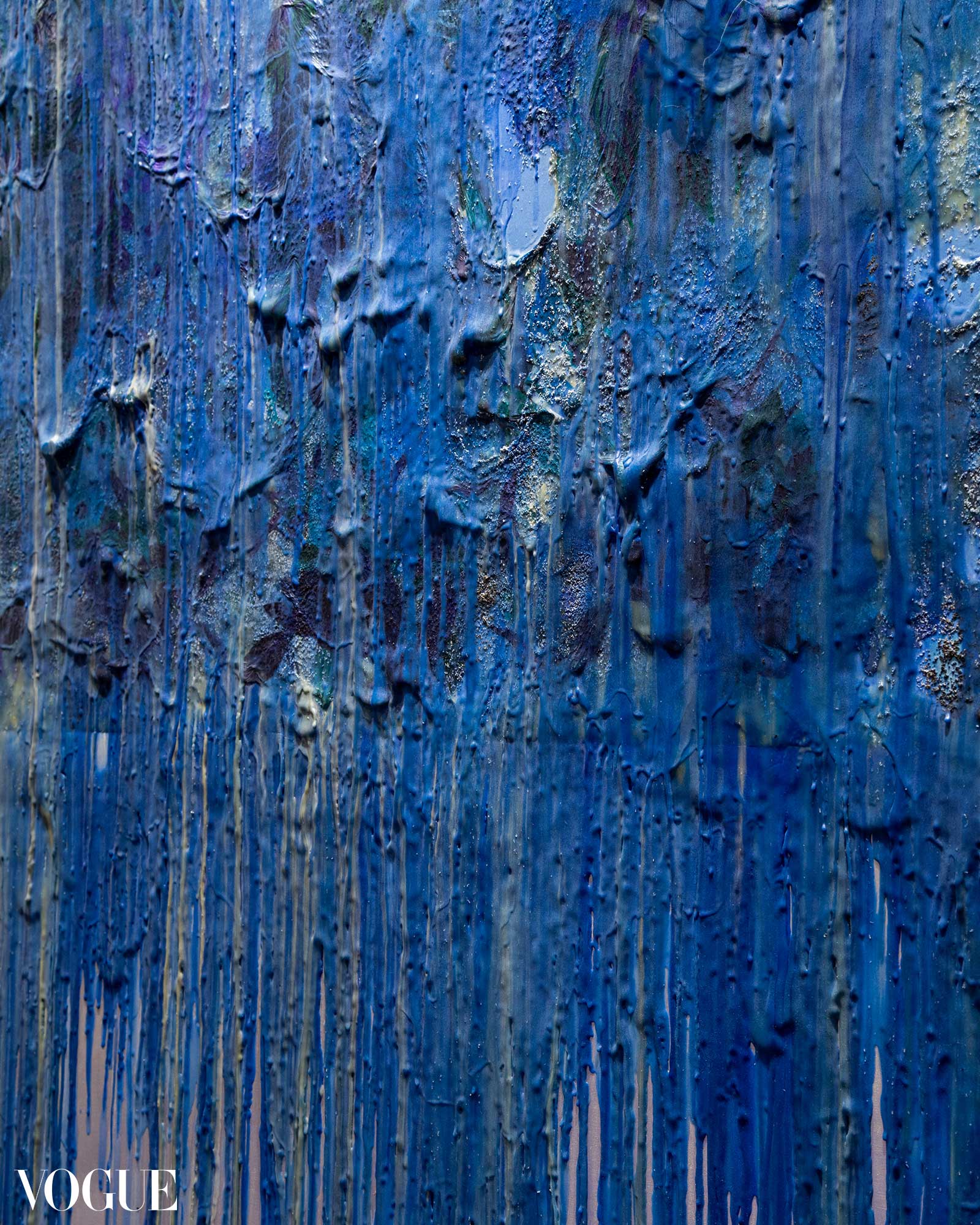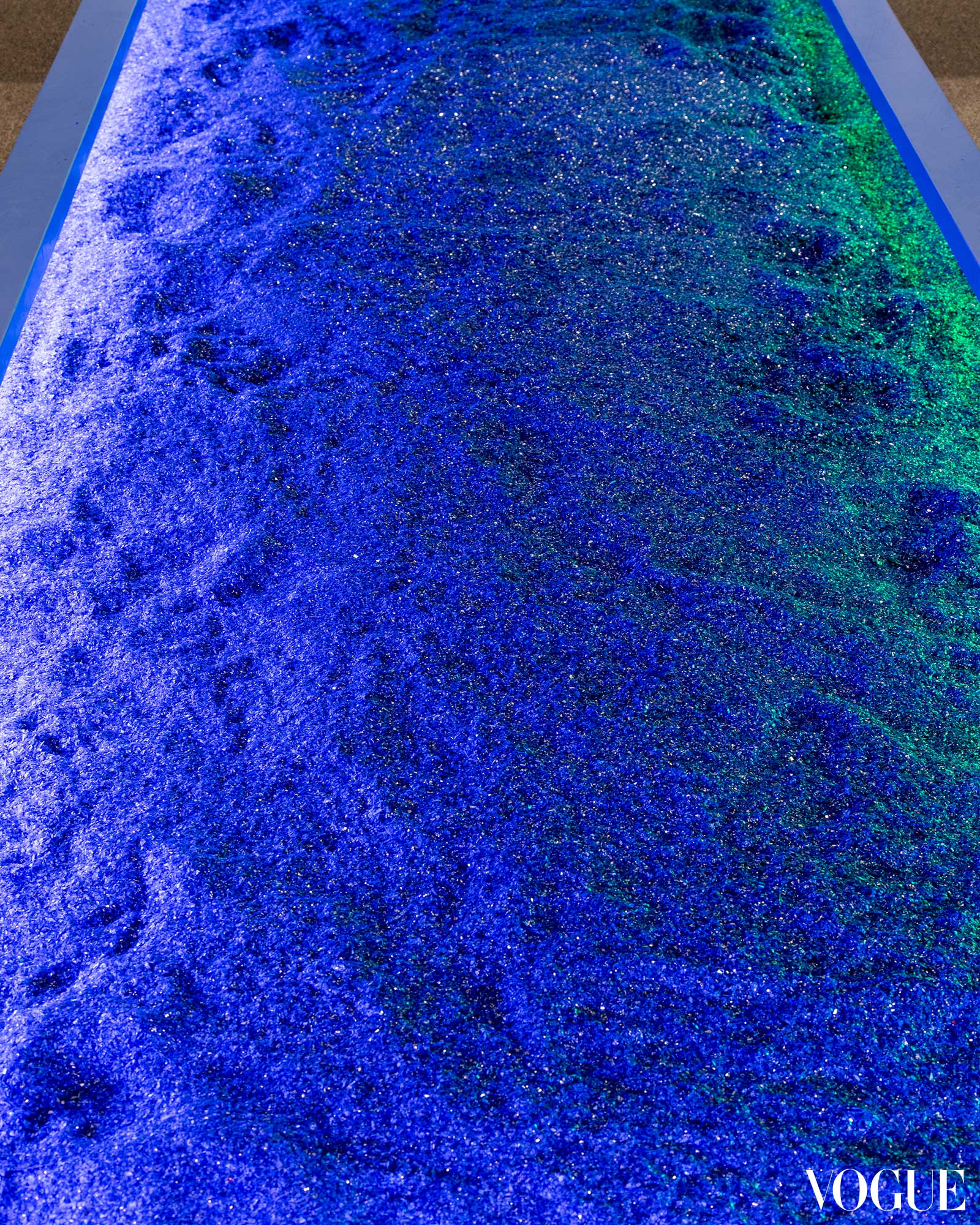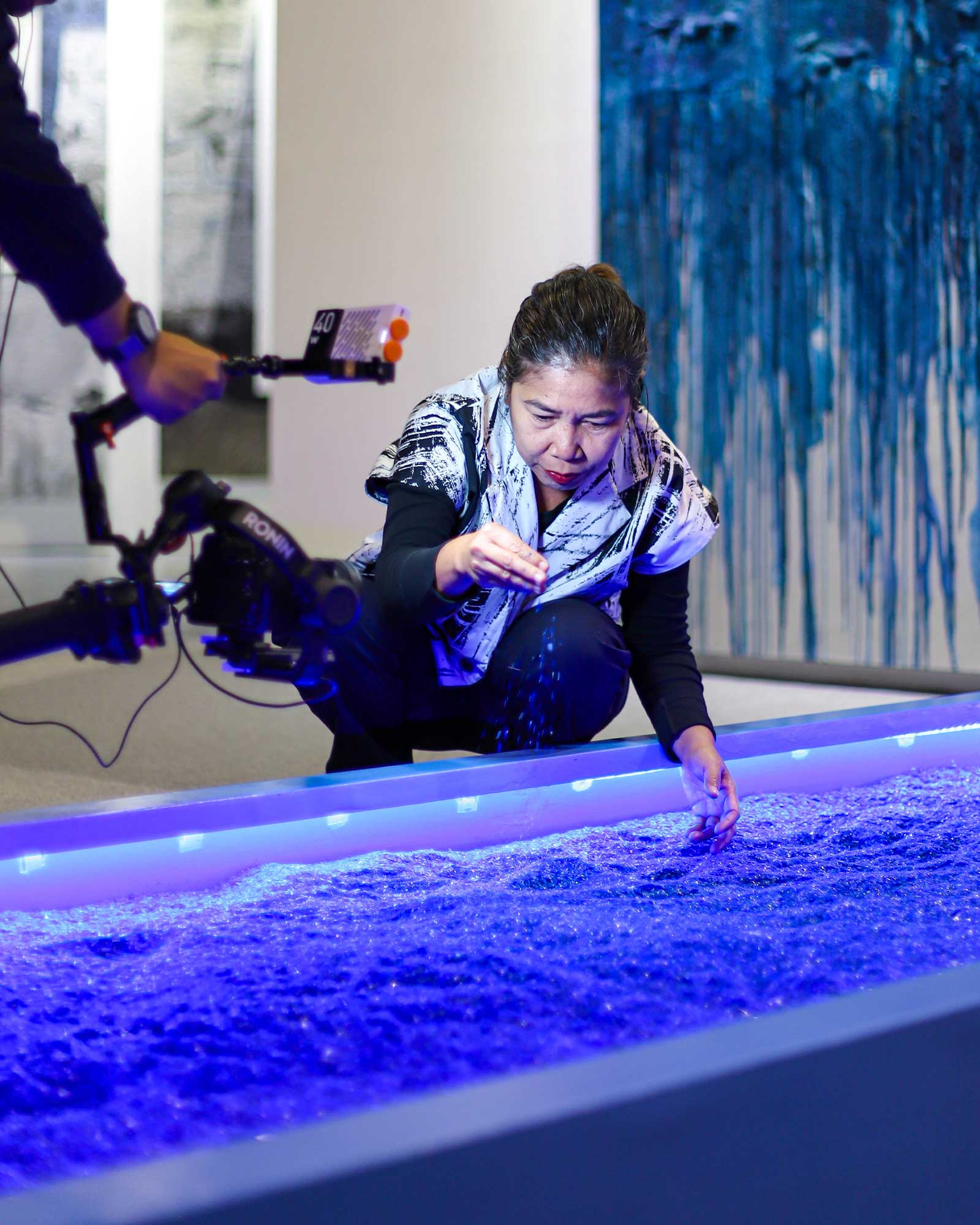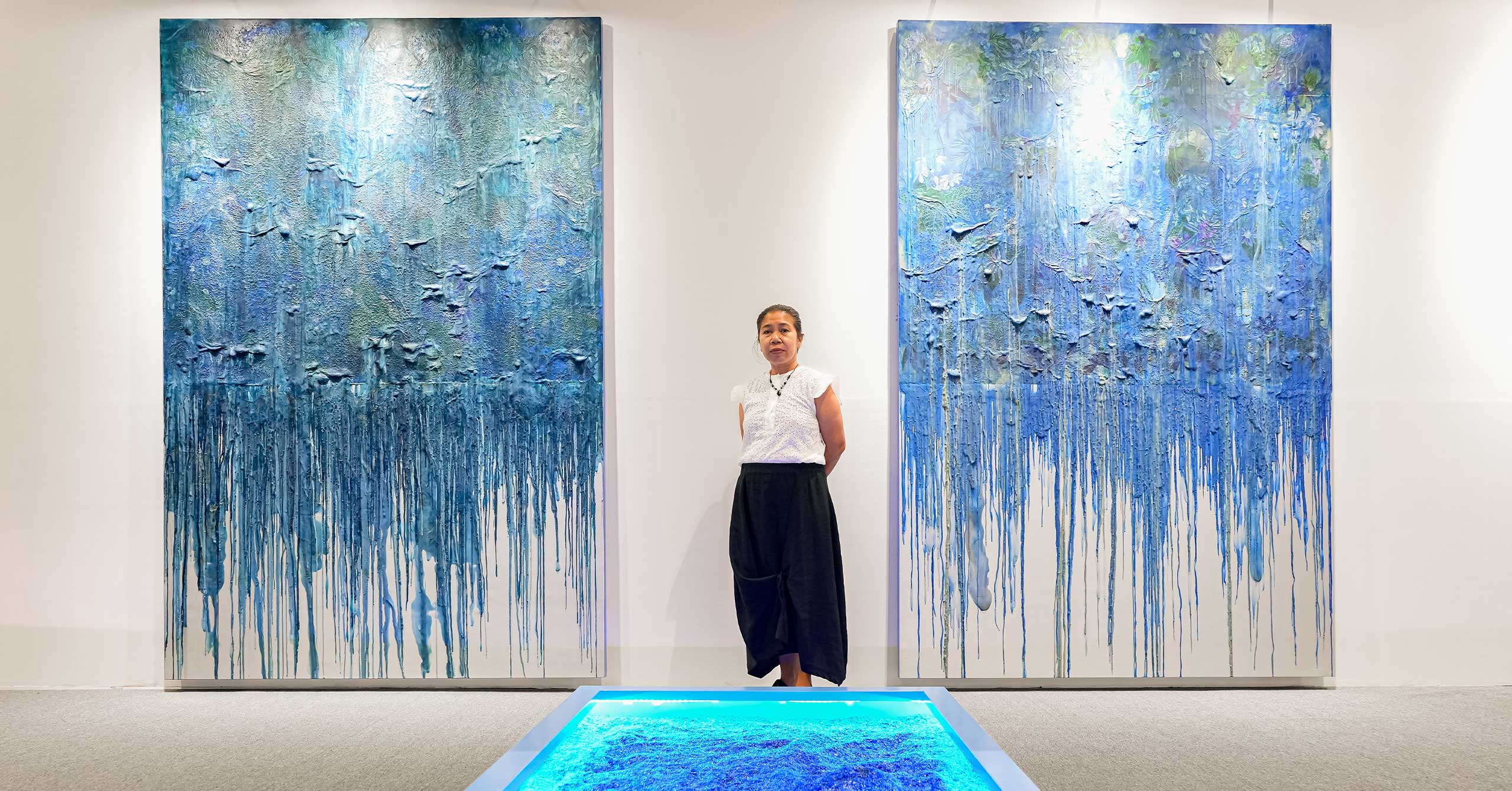Photo by Jea Avilla. Courtesy of Alt Fair Philippines
Photo by Jea Avilla. Courtesy of Alt Fair Philippines
Embroidery, painting, eco-printing, installation art— Geraldine Javier has done it all. The Filipina multi-disciplinary artist puts a playful curiosity and a profound wit at the center of her work, and the world is waiting to see what she does next.
At the center of the exhibition were two large wall-bound paintings drenched in a vivid blue, and a fluorescent lit, pool-like installation filled with finely shredded plastic fragments that almost resemble sand. In a wall not far behind were insect-like creatures made of embroidered fabric and various kinds of rust-corroded metal, encased in four glass frames. These are Geraldine Javier’s displays for ALT Fair Philippines 2024, showcasing the artist’s continued exploration of various mediums and techniques such as embroidery, metal work, and eco-printing, while tapping into compelling themes about destruction of nature and the apocalypse.
In a conversation with Vogue Philippines, Geraldine Javier illustrates the most defining characteristic of a master at work: their commitment to being a perpetual student.
One of your showcases at ALT Fair Philippines is entitled “Four Creatures and the Apocalypse.” You have integrated various iterations of creatures into your work, such as 2023’s “Creatures of the Anthropocene.” What makes “Apocalypse” different from your previous exhibitions involving creatures?
“Apocalypse” is the third iteration of my insect hybrid series. I started the first one, “Playing God in an Art Lab”, during the Singapore Tyler Print Institute (STPI) residency 12 years ago [and the pieces were made] with paper, preserved leaves, thread, and lithographs. I really wanted to repeat the series using different materials, and I had the chance to do the second iteration, “Creatures of the Anthropocene”, last year at my solo exhibition. I made several small embroideries using eco-printed fabrics, and they were very cute compared to [Four Creatures of the Apocalypse]. They were one-fourth the size of the pieces in this collection.
[These series] are about adaptation. In the previous series, it’s about being able to empathize with other creatures by becoming a hybrid, because the creatures in that series were a mix of human and animal skeletons. The creatures in that series were more playful and soft. Whereas “Apocalypse” does not include any human skeletons, and is [instead] about adaptation in a dystopian world.

The pieces in “Four Creatures and the Apocalypse” involve a lot of recycled metal work such as used nails of different sizes as well as scrap copper parts from a broken air conditioner. As a multidisciplinary artist working across a variety of mediums including paint and embroidery, how did you choose the materials and techniques you used for the artwork in this exhibition?
I’ve thought about integrating metal work into my art for a long time, as I’ve always wanted to do something sculptural. As our farm was being built, there were construction workers building with metal, so I told them, “Let’s do art today!”
The background for [these pieces] are eco-printed fabrics made of rust, and I am still exploring [eco-printing] because of its possibilities. I want to primarily use natural materials that are readily available to me such as leaves, plants, and metal scraps. Of course, we need to preserve artwork, but I want to create art that will eventually be absorbed by nature without polluting it. That’s my motivation.
Concepts of humanity and religion constantly intertwine across your body of work. Some of your significant pieces are an embroidery piece called “The Last Supper” (2011) and “Ella amo’ apasionadamente y fue correspondida” (2010), an unusual painting of the artist Frida Kahlo. How do you strike a balance between your investigation of faith through your art and your personal experience with it?
On “Ella Amo…”, which directly translates to “For she loved fiercely, and she is well-loved”, I depicted Frida Kahlo in that way: a painting that looks like a shrine to her, because so many people see her as a martyr. This is the image projected on her, “Saint Frida.” But she wasn’t completely a saint, she also had a mean streak.
“The Last Supper” had a major pun on religion. I have a very strong Catholic background—- from nursery to high school. [During this time period], I questioned the religious practices I was exposed to, since I couldn’t feel the sincerity in them. So, to get that out of my system, I created work that poked fun at religion without being blasphemous. I’ve always believed that there’s humor in the Bible. I’m sure Jesus himself had a sense of humor that some people just don’t get.

Going back to the showcase title, “Four Creatures of the Apocalypse,” How do you personally feel about the concept of an apocalypse? In creating this series, what feelings has it evoked in you throughout the process of each piece?
During the pandemic, I was so lucky because we were prepared. When everything shut down and there was nowhere to buy food and other supplies, we were stocked with seedlings and plants in our garden. Something I inherited from my mother is that she constantly pondered about the future, and she taught me to always prepare for it.
I’m never complacent—I always want to feel like I’m prepared. I always think about how the world isn’t perfect. Because death and mortality are themes that are always present in my work, people think, “Wow, she’s so brave,” because she’s dealing with these complex topics. But the truth is, I’m terrified— and maybe that’s why I show these themes in my work, because I’m trying to conquer my fears.
In your featured installation “Catch of the Day” and paintings “Seascape: Blue Hour I” and “Seascape: Blue Hour II”, you show the threat of single-use plastics to marine life and the environment. As an artist, do you think it’s important to create work that reflects the current state of the world, or do you think it’s better for artists to focus on their own selves and narratives?
Personally, I think it’s important for every artist to have an awareness of issues that are happening, because you can only say so much about yourself. It’s very limiting to only make work that’s about yourself, but of course, every artist needs to create personal work that’s not exclusively about politics or religion. Outside of that, artists should know that they are not alone. Artists should be in touch with their communities and the world, to see that their personal problems are not dissimilar to the problems that exist in the lives of others.


With this, do you believe that in art, “the personal is always political?”
Yes. I constantly say that I’m not a political artist, but still, there are politics involved in my work— I just try not to be too “preachy.”
In the art industry, many artists focus on one specific medium throughout their practice. Meanwhile, you explore and expand your skill set by learning and integrating with various mediums and techniques. What motivates you to pursue newer art styles and techniques despite not having prior experience? What are the challenges that come with it?
Perhaps continuously changing mediums is part of my evolution as an artist. Whenever I discover a new medium, I get obsessed. [For a period of time], I want to explore how I can work with it, and I also want to see how the medium itself will dictate me. Because I get obsessed, after two to three years, I’m sick of [the medium]. To be able to excite myself again and to stimulate my flow of ideas, I need to move on to different materials. Materials are very important to me, not the ideas alone— because those will follow. Once you have a mastery of the materials you want to use, ideas are very easy to produce. You can’t force [ideas] to come out altogether. What matters is you continue to practice with your materials.
When I started with eco-printing, I didn’t know a lot about it. I looked up tutorials on YouTube, read books about it, and I looked at photographs and results of the techniques. But I also figured: at some point, you need to stop looking at these images and techniques because you won’t be able to develop your own process and your own ideas. When I first started creating [Four Creatures and the Apocalypse], I made a lot of mistakes! But making mistakes is a huge part of creating art, because it provides a lot of lessons. You have to do it— and not just think about doing it.
You also have to learn to collaborate with other people. I understand that sometimes, it’s frightening to have collaborators because of the pressure of coming up with ideas on how to work together or how to make the collaboration process smoother, as well as the comfort of creating and doing things in your own time and space. However, it is very empowering to share your art and skills with other people, and to see them develop those skills.

Has this outlook on collaboration always been present throughout your career?
I used to do all the work myself, but some time in 2007, I met people I could teach embroidery to. Since then, I have been creating art where I can incorporate their skills. Collaboration has made my work richer, and the people I collaborate with challenge me to think about how I can help them develop their skills as creatives more. Because of this, I’m also able to focus on other work at the same time: when embroidery projects are done by other people, I can finish a painting. Collaboration has also improved my work flow.
Your recent work uses a lot of naturalistic elements, particularly flora growing in your own garden in Batangas. As an artist, is it important to you to reside or stay in a place that supports/influences the art you’re making?
When I was still in Manila, the materials that were at my disposal were different— I usually got them from Quiapo, Avenida, and from various thrift stores… but I wasn’t happy with [the materials I had]. I look back at a lot of my previous work and I feel bad because they don’t look good to me, but I also understood that [the work I made] was because of the materials available to me at the time.
At the time, I also didn’t know who I was as an artist yet, probably because I didn’t have the right materials that were meant for me. Staying in a place that supports the art you want to make is definitely important. When I moved to Batangas, it was as if my world changed. Instead of looking in, my perspective widened.
- Geraldine Javier’s Garden of Unearthly Delights
- “I see our islands as connected rather than fragmented”: The Vast And Layered Landscapes Of Artist Lui Medina
- How Costantino Zicarelli And Johanna Helmuth Created Their Custom Moreau Paris Bags For ALT Philippines 2024
- Less Champagne, Less Fried Chicken: Expect ‘Simpler Work’ at Jigger Cruz’s Art Fair Philippines 2024 Exhibit
